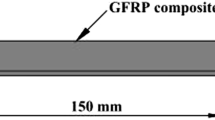Abstract
Seven composite material systems have been studied to determine their potential suitability for structural applications for continuous immersion in sea water. The matrices of these composites have been found to absorb moisture with saturation occurring at 0.6%–2% of the matrix weight of additional moisture over approximately 1% present after fabrication, when soaked at ambient temperature in simulated sea water, with 20.7 MPa (3000 p.s.i.) hydrostatic pressure giving a very minor increase in moisture absorption. Pure water absorption gave a slightly higher saturation level than did simulated sea water. With the exception of the graphite/vinylester composites, the degradation in transverse tensile strength and interfacial shear strength due to moisture absorption has been found to vary from 0%–22%, with the thermoset/graphite systems and the vinylester/glass systems both showing sufficient promise to justify further study. The observed correlation in the decrease in interfacial shear strength due to moisture absorption with decreases in transverse tensile strength supports the hypothesis that the moisture-induced degradation is associated with a decrease in the interfacial strength rather than the degradation of matrix mechanical properties. In situ fracture observations in the scanning electron microscope further support this hypothesis.
Similar content being viewed by others
References
P. J. C. Tamarelle and C. P. Sparks, in “Proceedings of Nineteenth Annual Offshore Technology Conference”, Houston, Texas, May 1987 (Richardson Texas: Offshore Technology Conference) p. 255.
G. S. Springer (ed.), in “Environmental Effects on Composite Materials”, Vol. I (Technomic, Westport, CT, 1981) p. 1.
C. E. Browning, in “Proceedings of the 1978 International Conference on Composite Materials: ICCM-2”, Toronto, Canada, April 1978, edited by B. R. Noton (Metallurgical Society of AIME, Warrendale, PA) p. 1527.
G. Menges and H. W. Gitshner, in “Proceedings of the Third International Conference on Composite Materials, ICCM-3”, Paris, August 1980, edited by A. R. Bunsell (Pergamon Press, New York) p. 597.
T. K. Tsotsis, PhD dissertation, Texas A and M University (1989).
A. C. Loos and G. S. Springer, “Environmental Effects on Composite Materials”, Vol. 1, edited by G. S. Springer (Technomic, Westport, CT, 1981) p. 34.
C. Schutte, W. McDonough, M. Shioya, M. McAuliffe and M. C Greenwood, Composites (special issue dedicated to the papers presented at the Interfacial Phenomena in Composite Materials '93, 13–15 September (1994) in press.
T. K. O'Brien, I. S. Raju and D. P. Garber, NASA TM-86437, Langley Research Center, Hampton, VA (1985).
B. J. Dewimille, R. Thoris and A. R. Bunsell, in “Proceedings of the Third International Conference on Composite Materials, ICCM-3”, Paris, August 1980, edited by A. R. Bunsell (Pergamon Press, New York) p. 689.
M. R. Piggott and P. S. Chua, Proceedings of ASME Pressure Vessel and Piping Conference, Honolulu, July 1989 (American Society of Mechanical Engineers, New York) p. 143.
S. K. Rege and S. C. Lakkad, Fibre Sci. Technol. 19 (1983) 317.
H. P. Abeysinghe, W. Edwards, G. Pritchard and G. J. Swampillai, Polymer 23 (1982) 1785.
A. C. Garg, Eng. Fract. Mech. 29 (1988) 127.
T. Jaska, “Effect of Water Immersion on Fiber/Matrix Adhesion”, Report CARDEROCKDIV-SME-92/38, Naval Surface Warfare Center (1993).
F. Pomies and L. A. Carlsson, J. Compos. Mater. 28 (1994).
G. M. Newaz, “Influence of Voids on Environmental Degradation of Epoxy Resins”, NATEC '83: Discovering New Frontiers Through Imagination (1983) p. 124.
J. F. Mandell, J. H. Chen and F. J. McGarry, Int. J. Adhes. Adhes. 1 (1980) 40.
M. Narkis, E. J. H. Chen and R. B. Pipes, Polym. Compos. 9 (1988) 245.
T. S. Grant and W. L. Bradley, J. Compos., submitted.
Author information
Authors and Affiliations
Rights and permissions
About this article
Cite this article
Bradley, W.L., Grant, T.S. The effect of the moisture absorption on the interfacial strength of polymeric matrix composites. JOURNAL OF MATERIALS SCIENCE 30, 5537–5542 (1995). https://doi.org/10.1007/BF00351570
Received:
Accepted:
Published:
Issue Date:
DOI: https://doi.org/10.1007/BF00351570



